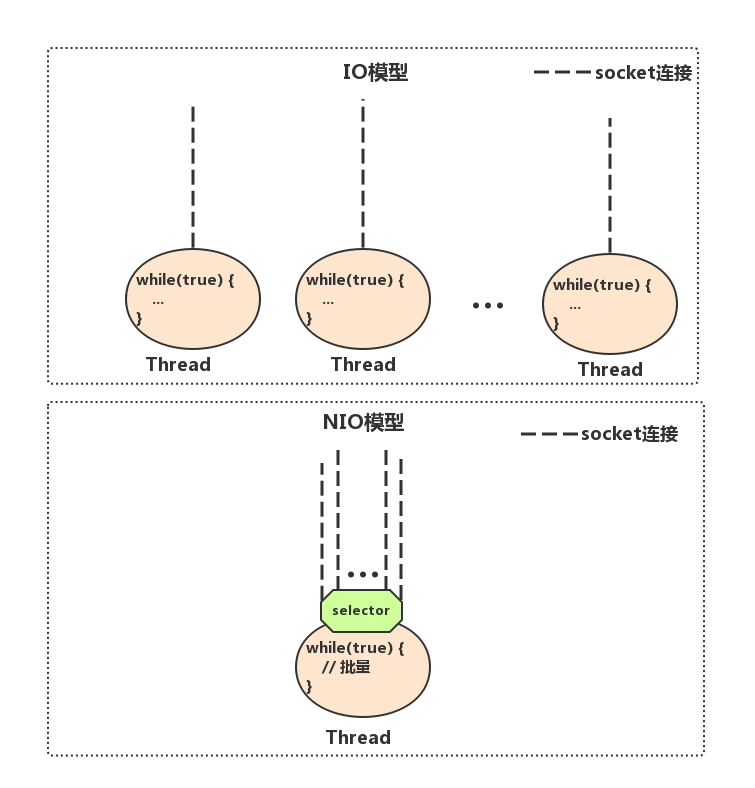Netty :
一个用来做sokect网络编程的高性能框架;
一个替代JDK NIO的优秀框架;
是大多数高并发/分布式框架的底层基础;
目录:
[TOC]
参考:基础介绍 https://www.jianshu.com/p/a4e03835921a
传统IO编程如何做c/s通信
IOServer
1
2
3
4
5
6
7
8
9
10
11
12
13
14
15
16
17
18
19
20
21
22
23
24
25
26
27
28
29
30
31
32
33
34
35
36
37
38
39
40
41
42
43
44
45
46
47
48
49
50
51
52
53
54
55
56
57
58
59
60
61
62
63
64
65
66
67
68
69
| package mxx.netty.io;
import java.io.IOException;
import java.io.InputStream;
import java.net.ServerSocket;
import java.net.Socket;
public class IOServer {
public static void main(String[] args) throws Exception {
ServerSocket serverSocket = new ServerSocket(8000);
new Thread(() -> {
while (true) {
try {
Socket socket = serverSocket.accept();
new Thread(() -> {
try {
String tName = Thread.currentThread().getName();
byte[] data = new byte[1024];
InputStream inputStream = socket.getInputStream();
while (true) {
int len;
while ((len = inputStream.read(data)) != -1) {
System.out.println(tName + '-' +new String(data, 0, len));
}
}
} catch (IOException e) {
}
}).start();
} catch (IOException e) {
}
}
}).start();
}
}
|
IOClient
1
2
3
4
5
6
7
8
9
10
11
12
13
14
15
16
17
18
19
20
21
22
23
24
25
26
27
28
| package mxx.netty.io;
import java.io.IOException;
import java.net.Socket;
import java.util.Date;
public class IOClient {
public static void main(String[] args) {
new Thread(() -> {
try {
Socket socket = new Socket("127.0.0.1", 8000);
while (true) {
try {
socket.getOutputStream().write((new Date() + ": hello world").getBytes());
socket.getOutputStream().flush();
Thread.sleep(2000);
} catch (Exception e) {
}
}
} catch (IOException e) {
}
}).start();
}
}
|
NIO编程 vs IO编程
IO编程问题:
1、1w个client连接对应server要开1w个线程去维护,继而1w个while死循环
2、线程资源受限:大量线程阻塞,操作系统耗不起
3、线程切换效率低下:要在1w个线程里来回切
4、数据读写是以字节流为单位,效率不高
如何解决以上问题的?
1、线程资源受限
新连接不再创建线程,而是批量绑定。
![1357217-1c856423372e7d5a 1357217-1c856423372e7d5a]()
一个循环如何监测1w个连接?
selector:新连接注册到selector上,批量监测出有数据可读的连接(同一时刻只有少量的连接有数据可读)
实际开发中,会开多个线程,每个线程都管理着一批连接,这样线程消耗大幅减少。
2、线程切换效率低下
NIO模型中线程数量大大降低,线程切换效率因此也大幅度提高
3、IO读写以字节为单位
NIO以字节块为单位读取,NIO维护一个缓冲区。
使用JDK原生NIO实现server
强烈不建议直接基于JDK原生NIO来进行网络开发
(看看注释就行了)
1
2
3
4
5
6
7
8
9
10
11
12
13
14
15
16
17
18
19
20
21
22
23
24
25
26
27
28
29
30
31
32
33
34
35
36
37
38
39
40
41
42
43
44
45
46
47
48
49
50
51
52
53
54
55
56
57
58
59
60
61
62
63
64
65
66
67
68
69
70
71
72
73
74
75
76
77
78
79
80
81
82
83
84
85
86
87
88
89
90
91
92
93
94
95
96
97
98
99
100
101
102
103
104
105
106
107
108
109
110
111
| package mxx.netty.m02_jdk_nio;
import java.io.IOException;
import java.net.InetSocketAddress;
import java.nio.ByteBuffer;
import java.nio.channels.SelectionKey;
import java.nio.channels.Selector;
import java.nio.channels.ServerSocketChannel;
import java.nio.channels.SocketChannel;
import java.nio.charset.Charset;
import java.util.Iterator;
import java.util.Set;
public class NIOServer {
public static void main(String[] args) throws IOException {
Selector serverSelector = Selector.open();
Selector clientSelector = Selector.open();
new Thread(() -> {
try {
ServerSocketChannel listenerChannel = ServerSocketChannel.open();
listenerChannel.socket().bind(new InetSocketAddress(8000));
listenerChannel.configureBlocking(false);
listenerChannel.register(serverSelector, SelectionKey.OP_ACCEPT);
while (true) {
if (serverSelector.select(1) > 0) {
Set<SelectionKey> set = serverSelector.selectedKeys();
Iterator<SelectionKey> keyIterator = set.iterator();
while (keyIterator.hasNext()) {
SelectionKey key = keyIterator.next();
if (key.isAcceptable()) {
try {
SocketChannel clientChannel = ((ServerSocketChannel) key.channel()).accept();
clientChannel.configureBlocking(false);
clientChannel.register(clientSelector, SelectionKey.OP_READ);
} finally {
keyIterator.remove();
}
}
}
}
}
} catch (IOException ignored) {
}
}).start();
new Thread(() -> {
try {
while (true) {
if (clientSelector.select(1) > 0) {
Set<SelectionKey> set = clientSelector.selectedKeys();
Iterator<SelectionKey> keyIterator = set.iterator();
while (keyIterator.hasNext()) {
SelectionKey key = keyIterator.next();
if (key.isReadable()) {
try {
SocketChannel clientChannel = (SocketChannel) key.channel();
ByteBuffer byteBuffer = ByteBuffer.allocate(1024);
clientChannel.read(byteBuffer);
byteBuffer.flip();
System.out.println(Charset.defaultCharset().newDecoder().decode(byteBuffer)
.toString());
} finally {
keyIterator.remove();
key.interestOps(SelectionKey.OP_READ);
}
}
}
}
}
} catch (IOException ignored) {
}
}).start();
}
}
|
Netty编程
概述:
1、Netty封装了JDK的NIO,用户友好
2、官话:”Netty是一个异步事件驱动的网络应用框架,用于快速开发可维护的高性能服务器和客户端。”
使用Netty不使用JDK原生NIO的原因:
1、JDK-NIO:使用复杂、BUG横飞
2、Netty底层IO模型随意切换(可以直接从NIO模型变身为IO模型)
3、简化开发,脱离细节,专注业务(Netty自带的拆包解包,异常检测等机制…)
4、Netty解决了JDK的很多BUG
5、Netty底层对线程,selector做了很多细小的优化
6、自带各种协议栈
7、Netty社区活跃
8、Netty已经历各大rpc框架,消息中间件,分布式通信中间件线上的广泛验证,健壮性无比强大
开始写代码…
maven
1
2
3
4
5
| <dependency>
<groupId>io.netty</groupId>
<artifactId>netty-all</artifactId>
<version>4.1.6.Final</version>
</dependency>
|
END
下一步:一个Netty实战项目






